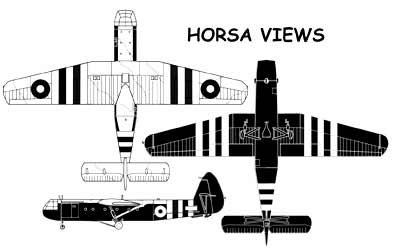


The British WWII "Airspeed" Horsa Invasion Glider
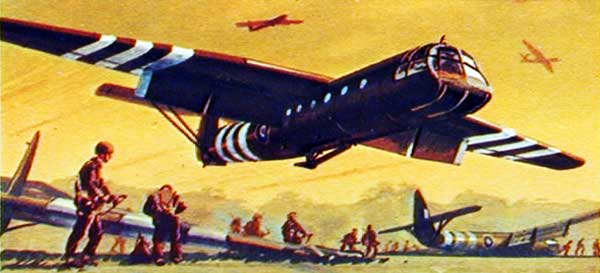
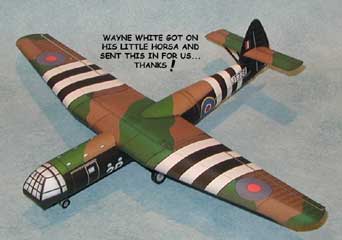 With the success of Germany's glider borne troops during the invasion
of France and the low countries, the Allies began looking at making
there own versions. The most successful British type was the Airspeed
Horsa and was built in large numbers. Equipped with
a large cargo door on the port side, jettison able tail and a nose
that swung upwards, the Horsa Invasion Glider
proved to be very capable. The type was used extensively during
most airborne operations involving British paratroops and was responsible
for airlifting nearly a quarter of air-supplied supplies during
the Normandy invasion.
With the success of Germany's glider borne troops during the invasion
of France and the low countries, the Allies began looking at making
there own versions. The most successful British type was the Airspeed
Horsa and was built in large numbers. Equipped with
a large cargo door on the port side, jettison able tail and a nose
that swung upwards, the Horsa Invasion Glider
proved to be very capable. The type was used extensively during
most airborne operations involving British paratroops and was responsible
for airlifting nearly a quarter of air-supplied supplies during
the Normandy invasion.
The Horsa was extremely maneuverable considering it was un-powered
and rather large. Huge flaps powered by compressed air and wing
mounted air brakes allowed the to stand on it's nose and swoop down
quietly to a landing, although the troops carried probably didn't
appreciate this much. Large numbers were also used by the U.S. Army.
Serendipity strikes again. A friend just gave me 44 issues of YANK magazine from 1944-45 published by the Army for the ETO(European Theater of Operations). One photo shows the Glider box "Shanty Town" the guys built after pulling and assembling the gliders. A guy is hanging out a window. If I remember correctly, it is on a golf course in England.
By the way, also tells of the green crew that bailed out of a B-24 with suspected engine runaway. The Liberator settled down without all the fledgling inputs and returned to fly over England for several hours with no crew and a full bomb load. Real interesting tale of how they verified it was empty and finally6 Spitfires were able to shoot it down over the ocean, one shooting his guns dry. ...Dennis Brooks (9/03)
I'm sure this isn't the first you've heard
of this, but as an artilleryman I took note of the info
under the 75mm Pack Howitzer picture on the HORSA Invasion
Glider Instruction sheet. There is one correction....The
Howitzer did not weigh 13,450 pounds. According to the Tech
Manual under weights--Howitzer and carriage (complete with
accessories)..1,440 lb. Wheel with tire (each).. 90 lb.
Some other interesting information. Yes, it could fire 6
rounds per minute for the first 4 minutes. The maximum range
was 9,620 yards (or just short of 5.5 miles). Not only could
it be pulled by a jeep, packed on a horse back, loaded in
a glider, loaded on a C-46, but it could also be packed
for parachute drop. Great models. I enjoy all. ...Jeff
(all fixed, chip) 4/07
I have just chanced on your website, specifically on the Horsa glider and must ask you to correct an error. The Horsa was not used to carry paratroops, they dropped by chute as the name of their regiment suggests. It was used to carry airborne soldiers of many regiments, including the Tank Corps, RASC South Staffs, RAMC etc. It was also used to land supplies of ammo, fuel, jeeps etc. but definately NOT paratroops. Yours, Frank Ashleigh. (Ex glider pilot 'A' Squadron) 4/8/09
AIRSPEED HORSA WWII INVASION GLIDER
This assault glider was used in many WWII airborne attacks, including the landing on Sicily and Normandy. The Horsa was a wooden high-wing aircraft, that was used on a large scale in the invasion of Sicily, Normandy and Germany. As well as troops, it could carry a jeep or a 6 lb gun --- the Mk.II had a hinged nose section. The Horsa was sturdy and maneuverable. 3655 (??)were built.
Development:
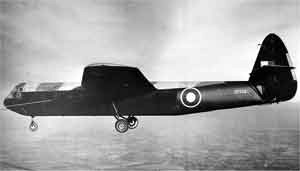 A.S.51 was developed in 1940 under specification X.26/40. A total of seven
prototypes were constructed, of which two were built by Fairey
and five by Airspeed. On September 12, 1940, first A.S.51 was
towed into the air by a "Whitley" bomber. First military
use of the gliders was British invasion of Sicily on July 10,
1943, in which 27 A.S.51 were used. Most famously, the Horsa was
use for the storming of the"Pegasus Bridge" Which signaled
the invasion of Allied forces in Europe in June 1944.
A.S.51 was developed in 1940 under specification X.26/40. A total of seven
prototypes were constructed, of which two were built by Fairey
and five by Airspeed. On September 12, 1940, first A.S.51 was
towed into the air by a "Whitley" bomber. First military
use of the gliders was British invasion of Sicily on July 10,
1943, in which 27 A.S.51 were used. Most famously, the Horsa was
use for the storming of the"Pegasus Bridge" Which signaled
the invasion of Allied forces in Europe in June 1944.
With the success of Germany's glider borne troops during
the invasion of France and the low countries, the Allies began
looking at making there own versions. The most successful British
type was the Airspeed Horsa and was built in large numbers.
Equipped with a large cargo door on the port side, jettison able
tail and a nose that swung upwards, the Horsa proved to be very
capable. The type was used extensively during most airborne operations and was responsible for airlifting
nearly a quarter of air-supplied supplies during the Normandy
invasion.
The Horsa was extremely maneuverable considering it was unpowered
and rather large. Huge flaps powered by compressed air and wing
mounted air brakes allowed the to stand on it's nose and swoop
down quietly to a landing, although the troops carried probably
didn't appreciate this much. A large numbers of the type were
also used by the U.S. Army.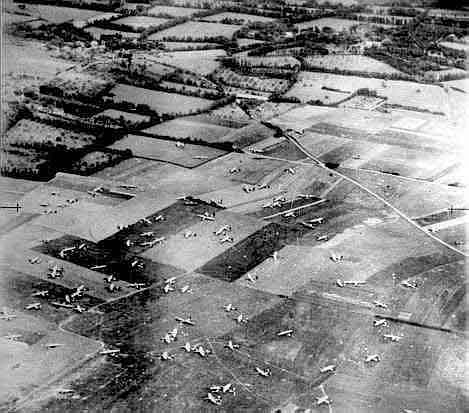
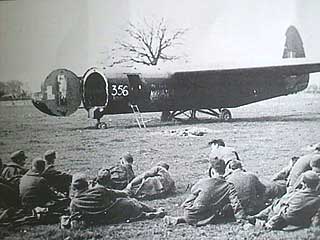 Taking a page from Hitler's book, America and Britain developed
their own combat glider programs. The American 15-place, Waco
CG-4A and British 30-place, Airspeed Horsa gliders were first
used in a major invasion (Operation Husky) on July 9, 1943 - the
start of the 38-day battle for Sicily.
Taking a page from Hitler's book, America and Britain developed
their own combat glider programs. The American 15-place, Waco
CG-4A and British 30-place, Airspeed Horsa gliders were first
used in a major invasion (Operation Husky) on July 9, 1943 - the
start of the 38-day battle for Sicily.
Other major operationswhere Allied gliders played a significant role were: Operation Thursday (Burma: March 1944);Operation Overlord (Normandy: June 1944); Operation Dragoon (Southern France: August 1944); Operation Market-Garden (Holland: September 1944); Operation Repulse (Bastogne: December 1944 - January 1945); and, on March 24, 1945, Operation Varsity (Rhine River Crossing).Six weeks after the successful conclusion ofVarsity, Nazi Germany surrendered to the Allies.
Operation Varsity was more costly to Allied airborne than the
invasion of Normandy. By early evening of March 24, in eight short
hours, our airborne forces had suffered 819 killed, 1,794 wounded
and 580 missing in action. Over six dozen glider-towing planes
were shot down. Seventy glider pilots were killed and 114 wounded
or injured. British and American glider-recovery teams found later
that less than 25 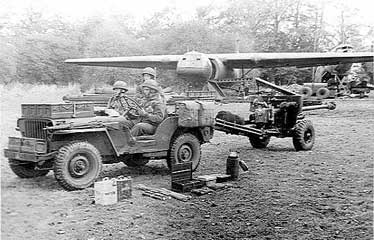 percent of the gliders landed unscathed.
percent of the gliders landed unscathed.
About 6,000 American glider pilots were trained. Almost 14,000 CG-4A's were built; about 3,600 were used in combat overseas.
Glider-rider and glider-pilot casualties were estimated at 40 percent for some missions. Specially trained glider-assault regiments were part of the U.S. 11th, 13th, 17th, 82nd and 101st Airborne Divisions. (British glider-assault teams were assigned to Air Landing Brigades, each equivalent in strength to a U.S. regiment.)
The 11th Airborne spearheaded Operation Gypsy Task Force, a glider-para drop attack on Japanese installations on Luzon, the Philippines. In the China-Burma-India Theater were glider units-assigned to the 1st, 2nd and 3rd Air Commando Groups - which flew British troops into battle behind the Japanese lines.
The Horsa was towed, with a hemp rope, behind the modified,
four-engine Handley-Page Halifax bomber, the twin-engine Armstrong
Whitworth Albemarle and the C-47.
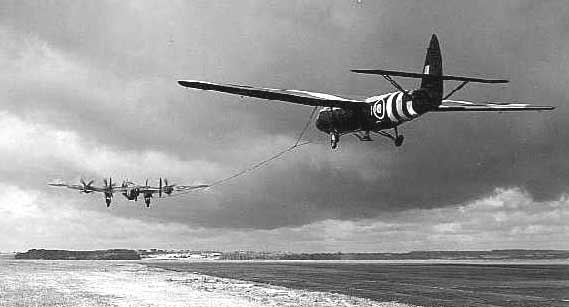
 Among those featured are gliders, the most famous of which
-- the CG-4A Waco -- was developed here at Wright Field, manufactured
by the Waco Aircraft Co. in nearby Troy, Ohio, and used successfully
by the Allies to invade France and cross the Rhine River into
Germany.
Among those featured are gliders, the most famous of which
-- the CG-4A Waco -- was developed here at Wright Field, manufactured
by the Waco Aircraft Co. in nearby Troy, Ohio, and used successfully
by the Allies to invade France and cross the Rhine River into
Germany.
Allied troops preferred the CG-4A because it was considerably stronger than other gliders, due to its metal frame; others would crumble like cardboard boxes if anything were in the way upon landing. And in a glider,troops had only one chance to land correctly.
How did Wright Field come to play an important role in glider history? With the Wright brothers' first, power-driven airplane developed in 1903, gliders might have been forced into history books as a thing of the past, but they made a huge comeback in the years that encompassed World War I -- as well as World War II.
Despite newer technology, gliders were revived by Germany
in the 1920s as a tactical necessity because the Treaty of Versailles,
which concluded World War I, restricted airplane production and
utilization. Later, Germany successfully used gliders in invasions,
as in 1939 when gliders carried troops and cargo for the invasion
of Poland.
Herman Goering, World War I pilot ace and leader of the Luftwaffe in World War II, said, "Our whole future is in the air. And it is by air power that we are going to recapture the German Empire. To accomplish this, we will do three things. First, we will teach gliding as a sport to all our young men. Then we will build up commercial aviation. Finally, we will create the skeleton of a military air force. When the time comes we will put all three together--and the German Empire will be reborn."
American government officials reasoned that with powered aircraft, there was little need for the glider. And as late as 1938 the War Department did not encourage a glider program because it could not conceive of the glider as a military weapon.
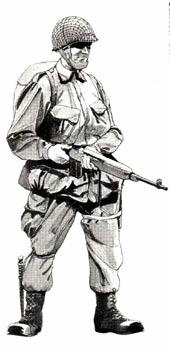
By 1940-41, the Germans were using gliders in many tactical missions to include the widely lauded invasion of Crete. In fact, Germany's successful military use of gliders proved to the American government that the concept of tactical gliders was worthy of exploration.
Thus, the War Department commissioned the American Glider Program headed by Lewin B. Barringer (later Major) until 1943 when his plane disappeared over the Caribbean. The program then moved to Headquarters, Army Air Force Office of the Special Assistant on the Army Air Force's Glider Program, under the direction of Richard C. DuPont.
A second tragedy plagued the glider program when DuPont was killed in a glider crash five months after his appointment. Yet, the mission would not die; his brother Maj. Felix DuPont was appointed to succeed him and directed the program from the Engineering Division at Wright-Patterson.
Relocated twice, before moving to Wright Field, the program became a function of the Aircraft Laboratory Engineering Division at Wright Field in the early 1940s.
Then one of the largest aviation research and development centers in the world during World War II, Wright Field tested gliders of many types under the War Department's American Glider Program.
By 1945, the Army Air Corps had developed and tested almost every type of tactical glider to include assault gliders, powered gliders, tow planes and cargo-carrying gliders, including ones from the Waco Aircraft Co.
American's faith in gliders became evident when the Air Corps placed an order for the procurement of 18,000 gliders varying in model configuration and purpose and ranging in price from $14,000 to $32,000 a glider. Of those, the Waco is most famous for its impact in the D-Day invasion when it carried thousands of nurses, troops, and equipment onto enemy fields, contributing most significantly to the defeat of Hitler's Army and to America's victory in World War II.
Today there is a CG-4A on display in the U.S. Air Force Museum at Wright-Patterson Air Force Base.
Assault glider used in many WWII airborne attacks, including the landing on Sicily and Normandy. The Horsa was a wooden high-wing aircraft, that was used on a large scale in the invasion of Sicily, Normandy and Germany. As well as troops, it could carry a jeep or a 6lb gun - the Mk.II had a hinged nose section. The Horsa was sturdy and maneuverable.
Missions
CHICAGO ~ Mission Chicago was the first
glider mission, scheduled to take off just after 0100 on 6 June
from Aldermaston in Berkshire. The flight consisted of fifty-three
Waco's towed by C-47s of the 434th Troop Carrier Group (TCG). Brigadier
General Donald Pratt (who was killed when his glider crashed into
a tree) commanded the mission. The gliders carried 153 glider men
of the 327th GIR (101st Airborne), along with anti-tank guns,
ammunition, jeeps, medical supplies, mines, grenades, water, etc.
This mission was scheduled to land in Normandy at 0400 at Landing
Zone East (LZE).
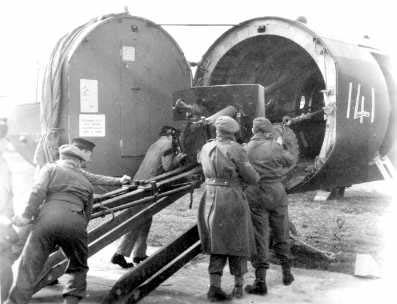
DETROIT ~ Mission Detroit was also scheduled to take off at 0100
on 6 June from Ramsbury in Wilts. The mission comprised fifty-two
CG-4As towed by the 437th TCG, carrying A and B Battery of the
80th AA Bn., HQ 82nd, HQ Artillery, and the 82nd A/B Signals.They
were scheduled to also land at 0400 further west from the Mission
Chicago landing zone (Landing Zone West or LZW).
KEOKUK ~ Mission Keokuk was the smallest of the six missions and
the first daylight mission. Thirty-two Horsa gliders carrying
the second of the two missions for the 327th GIR were scheduled
to leave from Aldermaston at 1830 on 6 June, towed by the 434th
TCG. Aboard the gliders were 157 glider men of the 327th, medical
and staff personnel, vehicles, howitzers and supplies. Keokuk
was to land at LZE at 2100.
ELMIRA ~ Mission Elmira was the largest glider mission of Normandy.
176 gliders from four different airfields would take part in this
mission, which because of the large number of gliders, was split
into two echelons so that not all the gliders would arrive over
the LZ at the sametime.
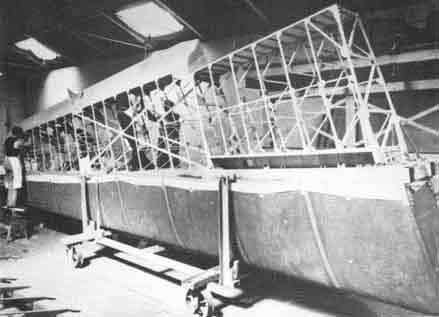 Wolverton Works played
a crucial role in the production of the Horsa. No factory
produced aircraft completely from start to finish. This
was to prevent production being totally destroyed by a
German air raid. Wolverton was chosen for for the manufacture
of the wings. Wolverton Works played
a crucial role in the production of the Horsa. No factory
produced aircraft completely from start to finish. This
was to prevent production being totally destroyed by a
German air raid. Wolverton was chosen for for the manufacture
of the wings. |
The first echelon was made up of two serials; the first serial was scheduled to depart from Ramsbury at 1840, the 437th Troop Carrier Group towing 8 CG-4As and 18 Horsa gliders. Aboard the gliders was C Battery 80th AA Battalion, Headquarters 80th, 82nd A/B Artillery and the 82nd A/B Signals. The second serial left from Greenham Commons in Berkshire at 1850. The 438th Troop Carrier Group towed 15 CG-4As and 35 Horsa gliders, carrying men of the 82nd A/B Recon., 82nd Signals, Headquarters 82nd, and 307th A/B Medical Company. Landings were scheduled for 2100 at LZW.
The second echelon was made up of two serials of fifty gliders each. Departure was one hour after the first echelon. The first serial, consisting of 2 CG-4As and 48 Horsa gliders, was towed by the 436th Troop Carrier Group from Memsbury in Berkshire. Aboard the gliders was the 319th Glider Field Artillery (GFA) Battalion, 320th GFA Battalion, 307th A/B Medical Co., A Co. 307th A/B Engineer Battalion, and the 82nd A/B Artillery.
The second serial left from Welford in Berkshire, 12 CG-4A and
38 Horsa gliders towed by the 435th Troop Carrier Group. This
flight was mostly made up of the 320th GFA Battalion (82nd A/B),
along with their howitzers, ammunition, and jeeps. Mission Elmira was the last of the glider missions scheduled for
D-Day.
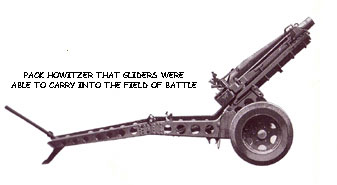 GALVESTON ~ Mission Galveston, comprised 100 gliders split into
two serials. Serial one was scheduled to leave from Ramsbury at
0430 on 7 June (D+1). Comprised of 32 CG-4As and 18 Horsa's, they
were towed by the 437th Troop Carrier group. The gliders carried
the 1st Battalion 325th Glider Infantry and A Co. 307th A/B Engineer
Bn., 717 glider men in all. Serial two left from Aldermaston with fifty Waco's towed
by the 434th Troop Carrier Group.This flight carried the Headquarters
325th GIR, Co. A 307th A/B Engr. Bn., 82nd A/B Recon., 82nd A/B
Division Artillery, 25 jeeps and 20 guns.
GALVESTON ~ Mission Galveston, comprised 100 gliders split into
two serials. Serial one was scheduled to leave from Ramsbury at
0430 on 7 June (D+1). Comprised of 32 CG-4As and 18 Horsa's, they
were towed by the 437th Troop Carrier group. The gliders carried
the 1st Battalion 325th Glider Infantry and A Co. 307th A/B Engineer
Bn., 717 glider men in all. Serial two left from Aldermaston with fifty Waco's towed
by the 434th Troop Carrier Group.This flight carried the Headquarters
325th GIR, Co. A 307th A/B Engr. Bn., 82nd A/B Recon., 82nd A/B
Division Artillery, 25 jeeps and 20 guns.
HACKENSACK ~ Mission Hackensack was the final glider assault into
France. It too was made up of two serials of fifty gliders each.
Serial one was scheduled to take off at 0630 from Upottery in
Devon, towed by the 439th Troop Carrier Group. Twenty Waco's and
thirty Horsa's carrying the 2nd Battalion 325th GIR, 2 Battalion
401st (assigned as the 3rd Battalion 325th GIR), 3 jeeps and 10
tons of ammunition. Over 950 soldiers were scheduled to land at
LZW at 0900. The second serial was scheduled for 0700 from Merryfield in Somerset.
Fifty Waco's, towed by the 441st Troop Carrier Group, would carry
the 2nd Battalion 325th GIR, 2nd Battalion 401st GIR, 20 jeeps
and 12 81mm mortars.
Before D-Day it was feared that the glider forces would face losses
nearing 50-70% before they even got into combat, due to crash
landings and the German defenses. It was felt by some that these
men were simply being sacrificed for no gain. General Eisenhower
insisted that the glider assault take place. The actual initial
losses in crash landings and other causes were only 10-15%, and
the glider forces proved crucial to the success of the invasion
at Utah Beach.
Versions: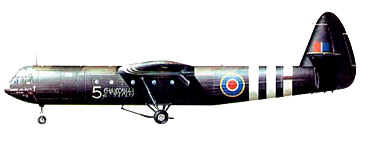
AIRSPEED AS.51 HORSA - Hessell Tiltman designed the Airspeed Horsa to Specification X.26/40 as Britain's first major troop-carrying glider. Of all-woodconstruction, the Horsa was designed for dispersed production by companies outside the aircraft industry. Design and construction of first two prototypes (DG597 and DG603) at Salisbury Hall, London Colney, for assembly at Fairey's Great West Aerodrome and first flight on September 12, 1941, behind a Whitley tug; five more prototypes built and test-flown at Portsmouth.
Airspeed Horsa Mk I: Initial production version to carry 20-25
troops. 470 built by Airspeed at Christchurch, 300 by Austin Motor
Co and 1,461 by Harris Lebus and Associates. First operation November
19, 1942 (two Horsa's towed by Halifaxes) against Norwegian heavy
water plant in Norway; first major deployment, invasion of Sicily,
July 1943. Projected AS.52 to specification X.3/41 designed (but
not built) to carry up to 8,000 lbs of bombs. Powered version
with two 375 hp Cheetah Xs also projected, along with AS.53 vehicle-carrying
glider.
Airspeed Horsa Mk II: Version
of AS.53 further developed in 1943 as AS.58 with hinged nose and
reinforced floor to carry vehicles; twin nose wheels, and twin
tow-rope attachment moved from under wing to nose wheel strut.
225 built by Airspeed at Christchurch; 65 by Austin Motor Co;
1,271 by Harris Lebus Group. Extensively used (some in USAAF markings)
in D-Day landings and subsequent operations up to crossing of
the Rhine in March 1945. A few to India for trials. Tugs included
Stirling, Halifax, Albemarle, Whitley and, rarely, Dakota. Gross
weight increased to 15,750 lb.
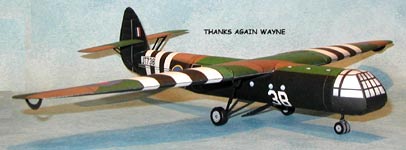
Specifications
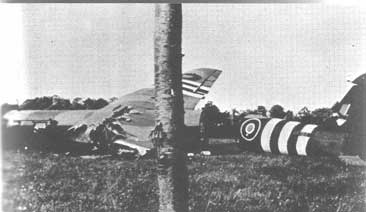 |
Crashed Horsa Invasion Glider, crash landing on D-Day. |



